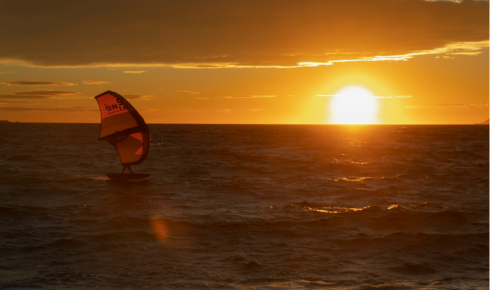The evolution of hydrofoil technology has revolutionized how we approach wind-based water sports. Two major disciplines have emerged at the forefront of this revolution: windfoil and wingfoil. At first glance, they may seem quite similar—both involve boards equipped with a hydrofoil, both rely on wind for propulsion, and both give riders the magical experience of flying above the water. But when you dig a little deeper, you’ll quickly see that the experience, skill requirements, and equipment setups for these two sports differ in significant ways. If you’re considering getting into one of them, understanding their distinctions can help you make an informed decision tailored to your preferences, physical condition, location, and long-term goals.
The Basics: What Is Windfoil vs. Wingfoil?
Let’s start by defining the two disciplines. Windfoiling is a direct descendant of windsurfing. It uses a traditional windsurfing rig mounted on a foil board. The sail is attached to the board via a mast base, and the rider controls direction and power by manipulating the sail with a boom. Once enough speed is generated, the foil lifts the board above the surface, drastically reducing drag and increasing speed.
Wingfoiling, by contrast, is a newer innovation. The rider holds a free-floating inflatable wing in their hands, separate from the board. This wing captures wind like a kite or sail, but it’s not attached to the board. The board itself is usually smaller than a windfoil board, and the rider uses both the wing and body weight to steer and control the ride. Unlike windfoiling, there are no mast tracks or foot straps required, making it appear simpler on the surface.
One significant consideration is the learning curve. Windfoil generally requires a background in windsurfing, as the skills of sail handling, tacking, and jibing are transferred directly from traditional windsurfing. The board is also less stable when at rest, which can challenge newer riders. Wingfoil, on the other hand, is often seen as more beginner-friendly because the wing is easier to control and less physically demanding in terms of sail management. That said, wingfoil boards can also be unstable, especially for heavier riders or those without board sport experience. In both sports, understanding your foil setup, including surf foil parts such as the mast, fuselage, and wings, is crucial for performance and safety.
Practical Differences: Portability, Gear, and Setups
When it comes to equipment, both sports require a hydrofoil, but their gear lists diverge quickly. Windfoiling uses a complete windsurfing rig: mast, boom, sail, mast base, and board. The setup is bulky, complex to rig, and often requires transport via roof racks or trailers. This can be a limiting factor for people who lack storage space or transport options.
Wingfoiling, by contrast, is much more compact. The inflatable wing packs down into a backpack, and the boards are typically smaller than windfoil boards. There are fewer components to worry about, and setup time is significantly shorter. If convenience and portability are high priorities for you, wingfoil is likely the better fit.
Another area where the two sports differ is in wind range versatility. Windfoiling tends to require a more consistent wind range, often around 12 to 25 knots, and the rig size needs to be adjusted based on the wind conditions. Wingfoiling has a surprisingly large wind range, especially when using newer wings with better efficiency. In addition, modern wing designs include windows and improved aerodynamics, making the experience safer and more intuitive. That said, windfoil still holds the edge in terms of upwind and downwind angles due to the sail’s rigidity and mast leverage.
One factor that shouldn’t be overlooked is water access. Windfoil, like windsurfing, often requires a beach with some room to maneuver and launch. The longer boards and sails are less forgiving in tight areas. Wingfoil can be launched from tighter spots, including harbors, docks, or even standing in the water and pumping the wing to get going. This flexibility opens up more locations for practice and enjoyment.
Both disciplines rely heavily on the correct choice and configuration of surf foil parts, and riders should familiarize themselves with the differences in mast length, front wing surface area, and rear stabilizer configurations. Windfoil setups often benefit from longer masts and flatter, faster wings, while wingfoil setups prioritize control and low-speed lift, especially for beginners.
Performance, Progression, and Personal Goals
Performance-wise, both sports can offer exhilarating rides, but they cater to slightly different thrills. Windfoil offers high-speed potential and excellent upwind/downwind angles, making it an exciting choice for those who love covering distance or crave the sensation of speed. It’s well-suited for lakes or coastal areas with side-shore winds and space to maneuver.
Wingfoil is more versatile in terms of tricks and freeride playfulness. The hand-held wing allows for more movement and creativity—think jumps, rotations, and even surfing waves with minimal wind assistance. For riders interested in combining foil riding with surf-style maneuvers, wingfoiling opens a world of freestyle and wave-riding possibilities.
In terms of progression, wingfoil arguably has the steeper initial learning curve but offers faster rewards once basic skills are mastered. Many find themselves foiling in a few sessions with the right setup and conditions. Windfoil, while easier to transition into for seasoned windsurfers, may feel more physically demanding and technically rigid to newcomers.
Looking ahead, think about where you want to take the sport. If you’re someone who wants to cover long distances, race, or benefit from existing windsurfing experience, windfoil is a logical choice. But if you’re drawn to versatility, convenience, and trick potential—or if you surf and want to add wind power to your sessions—wingfoil may be more rewarding.
FAQ – Windfoil vs. Wingfoil
Which one is easier to learn: windfoil or wingfoil?Wingfoil tends to be more accessible for complete beginners, especially those with no prior windsurfing experience. Windfoil is easier for windsurfers but has a steeper learning curve for others.
What’s the biggest difference in equipment between the two?Windfoil uses a fixed sail rig and more components (mast, boom, sail), while wingfoil uses a lightweight, inflatable handheld wing. Wingfoil gear is typically more compact and easier to transport.
Can I use the same foil setup for both sports?Sometimes, but not always. While some surf foil parts (like the mast or fuselage) can be compatible, wing designs and board mounts differ. Make sure to consult the manufacturer before mixing parts across disciplines.
Which is better for light wind conditions?Wingfoil with larger wings and high-aspect foils performs surprisingly well in light wind. Windfoil may struggle unless paired with large sails and advanced techniques.
Is one more physically demanding than the other?Windfoil can be more taxing on the upper body and core due to the fixed sail and stance. Wingfoil distributes effort more evenly and allows for more rest between efforts.
Which one offers more variety in terms of tricks and wave riding?Wingfoil shines in versatility. Its detached wing allows for jumps, spins, and wave rides that aren’t possible—or are much harder—on a windfoil setup.





